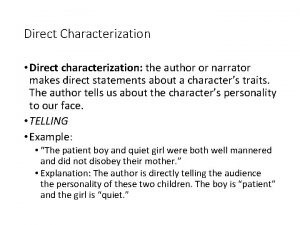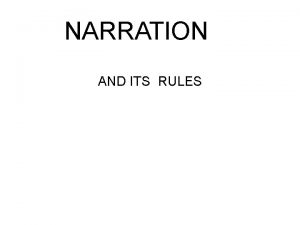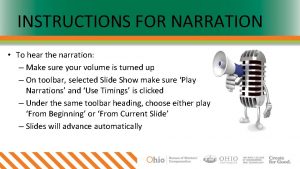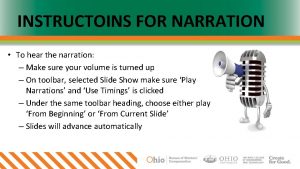Character and Narration A good character has some













- Slides: 13

Character and Narration

• A good character has some kind of internal conflict. • A character who has no problems becomes unbelievable and boring. • Impossible to write without a really clear sense of how your character views the world and their place in it. • Without a conflict, a story will have no shape. Where would Lady Macbeth be without her guilt and Hamlet be without his desire for revenge?

• Characters who are not surprising are stereotypes, e. g. they behave in a way we expect. • A good character building exercise is to give him/her different settings and situations, and try to write them into each one, e. g. being left behind on an oil rig; being stuck with 2 people you hate in a lift; on a beach in Ibiza; in an African village. How does your character adapt/react to different environments/situations?

• Development of character relies on consequence, on the way in which the world creates and shapes us. • Before you even start to write a word of your story, write some character sketches. • Write an imagined history for your characters. Always ask, Why? Why is my character like this? Why do they feel this way? Characters, like real people, have histories, places they came from, ideas about the world, families etc.

2 good ways to get to know your character: 1. 2. Interview them. Ask your character about 30 questions, from ‘What is your favourite colour? ’ to ‘How do you feel about your parents? ’ Make a list of likely things they would carry around with them. These things must reflect the person they are.

• Characters need to have reasons/motivations/conflicts. • What makes a character interesting is not the way that the world impacts upon the character, but the way in which the character impacts upon the world.

• When you write a profile on a character, you will write a MUCH better story. Note: your character may have a phobia of spiders, which will make it very interesting when they are sleeping in a hammock on the Galapagos Islands, trying to impress someone who isn’t interested in them. Meanwhile, lots of tarantulas are crawling around.

Having created a character profile – you will know how your character will react. • Alan Bennett in ‘The Clothes They Stood Up In’ has a back story to his characters: the opening sentences are: “The Ransomes had been burgled. ‘Robbed, ’ Mrs Ransome said. ‘Burgled, ’ Mr Ransome corrected. ”

• Bennett starts the story with a conflict – an argument/inconsistency between a married couple. Readers will be forming ideas about the relationship – which is great – Bennett does not need to ‘explain’ it, and readers will be more interested because they have to think about what’s going on. • A key to writing well, is to allow your readers to work things out. This is all part of SHOW DON’T TELL.

• For the story and character to evolve, the character needs to be tested by the events of a story. Your character will then come to life on the page through scenes and dialogue. They will start to say and do things of her own accord. • Once you have a character and situation, you need to jot down events that may happen in your story.

ACTIVITY 1 • Creating character Profiles (see handouts)

ACTIVITY 2 Find someone to work with: 1. Individually invent a character in your head, or think of one you’ve already considered. 2. Do not write a description of your character, but write a description of their living room. Write only what you see. 3. Swap descriptions with your partner. 4. Read, then tell your partner what sort of character would own a room like that. 5. Did your partner describe your character accurately? If not, think about the things you can add to your description.

ACTIVITY 3 Do 2 of the following. Write about a paragraph. • a dialogue between your character and someone else - the other person is infatuated and doesn’t realise your character can’t stand them. • show your character in a café and his/her partner didn’t come home last night: firstly they are waiting for their friend to turn up, secondly the friend arrives. • list the contents of your character’s handbag/rucksack/briefcase/pockets.
 Zoroastrianism beliefs
Zoroastrianism beliefs C. good evening
C. good evening Good afternoon animado
Good afternoon animado You are good when theres nothing good in me
You are good when theres nothing good in me Good afternoon students
Good afternoon students What are some contact forces and some noncontact forces
What are some contact forces and some noncontact forces Some trust in horses
Some trust in horses Which narration reveals a character with a shy personality
Which narration reveals a character with a shy personality Paragraph on good character
Paragraph on good character They say it only takes a little faith
They say it only takes a little faith Sometimes you win some
Sometimes you win some Countable and uncountable ice cream
Countable and uncountable ice cream Some say the world will end in fire some say in ice
Some say the world will end in fire some say in ice Some say the world will end in fire some say in ice
Some say the world will end in fire some say in ice

























